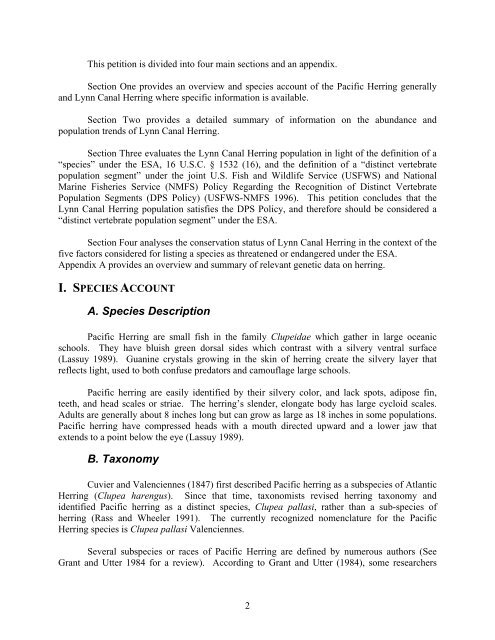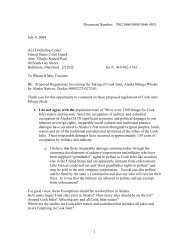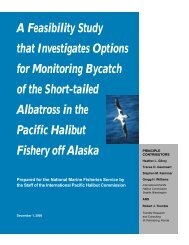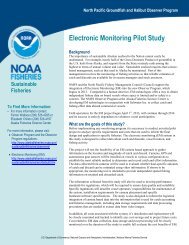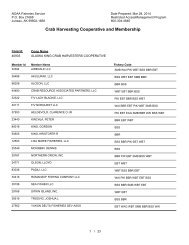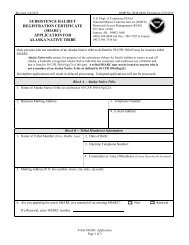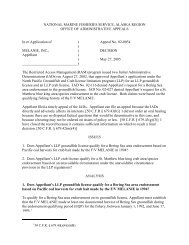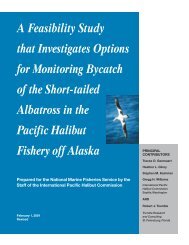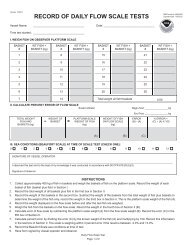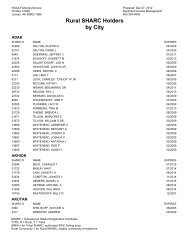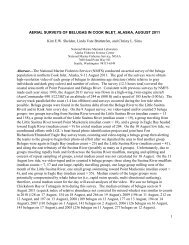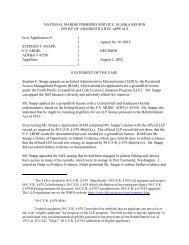Petition to List Lynn Canal Pacific Herring under the Endangered ...
Petition to List Lynn Canal Pacific Herring under the Endangered ...
Petition to List Lynn Canal Pacific Herring under the Endangered ...
Create successful ePaper yourself
Turn your PDF publications into a flip-book with our unique Google optimized e-Paper software.
This petition is divided in<strong>to</strong> four main sections and an appendix.<br />
Section One provides an overview and species account of <strong>the</strong> <strong>Pacific</strong> <strong>Herring</strong> generally<br />
and <strong>Lynn</strong> <strong>Canal</strong> <strong>Herring</strong> where specific information is available.<br />
Section Two provides a detailed summary of information on <strong>the</strong> abundance and<br />
population trends of <strong>Lynn</strong> <strong>Canal</strong> <strong>Herring</strong>.<br />
Section Three evaluates <strong>the</strong> <strong>Lynn</strong> <strong>Canal</strong> <strong>Herring</strong> population in light of <strong>the</strong> definition of a<br />
“species” <strong>under</strong> <strong>the</strong> ESA, 16 U.S.C. § 1532 (16), and <strong>the</strong> definition of a “distinct vertebrate<br />
population segment” <strong>under</strong> <strong>the</strong> joint U.S. Fish and Wildlife Service (USFWS) and National<br />
Marine Fisheries Service (NMFS) Policy Regarding <strong>the</strong> Recognition of Distinct Vertebrate<br />
Population Segments (DPS Policy) (USFWS-NMFS 1996). This petition concludes that <strong>the</strong><br />
<strong>Lynn</strong> <strong>Canal</strong> <strong>Herring</strong> population satisfies <strong>the</strong> DPS Policy, and <strong>the</strong>refore should be considered a<br />
“distinct vertebrate population segment” <strong>under</strong> <strong>the</strong> ESA.<br />
Section Four analyses <strong>the</strong> conservation status of <strong>Lynn</strong> <strong>Canal</strong> <strong>Herring</strong> in <strong>the</strong> context of <strong>the</strong><br />
five fac<strong>to</strong>rs considered for listing a species as threatened or endangered <strong>under</strong> <strong>the</strong> ESA.<br />
Appendix A provides an overview and summary of relevant genetic data on herring.<br />
I. SPECIES ACCOUNT<br />
A. Species Description<br />
<strong>Pacific</strong> <strong>Herring</strong> are small fish in <strong>the</strong> family Clupeidae which ga<strong>the</strong>r in large oceanic<br />
schools. They have bluish green dorsal sides which contrast with a silvery ventral surface<br />
(Lassuy 1989). Guanine crystals growing in <strong>the</strong> skin of herring create <strong>the</strong> silvery layer that<br />
reflects light, used <strong>to</strong> both confuse preda<strong>to</strong>rs and camouflage large schools.<br />
<strong>Pacific</strong> herring are easily identified by <strong>the</strong>ir silvery color, and lack spots, adipose fin,<br />
teeth, and head scales or striae. The herring’s slender, elongate body has large cycloid scales.<br />
Adults are generally about 8 inches long but can grow as large as 18 inches in some populations.<br />
<strong>Pacific</strong> herring have compressed heads with a mouth directed upward and a lower jaw that<br />
extends <strong>to</strong> a point below <strong>the</strong> eye (Lassuy 1989).<br />
B. Taxonomy<br />
Cuvier and Valenciennes (1847) first described <strong>Pacific</strong> herring as a subspecies of Atlantic<br />
<strong>Herring</strong> (Clupea harengus). Since that time, taxonomists revised herring taxonomy and<br />
identified <strong>Pacific</strong> herring as a distinct species, Clupea pallasi, ra<strong>the</strong>r than a sub-species of<br />
herring (Rass and Wheeler 1991). The currently recognized nomenclature for <strong>the</strong> <strong>Pacific</strong><br />
<strong>Herring</strong> species is Clupea pallasi Valenciennes.<br />
Several subspecies or races of <strong>Pacific</strong> <strong>Herring</strong> are defined by numerous authors (See<br />
Grant and Utter 1984 for a review). According <strong>to</strong> Grant and Utter (1984), some researchers<br />
2


